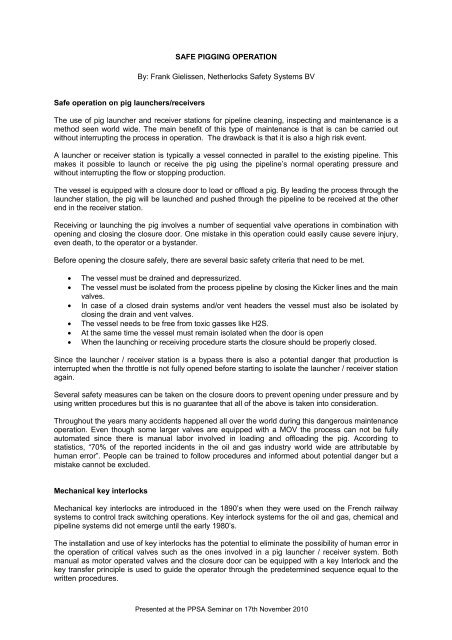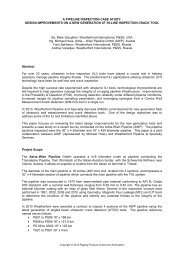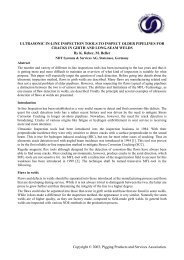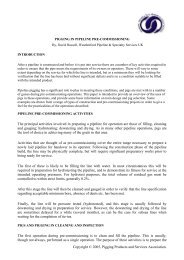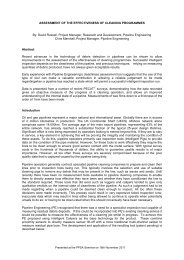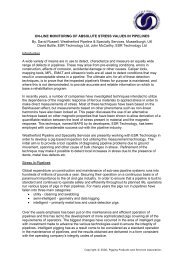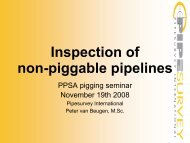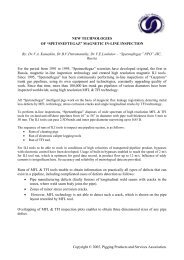safe pigging operation - PPSA, the Pigging Products and Services ...
safe pigging operation - PPSA, the Pigging Products and Services ...
safe pigging operation - PPSA, the Pigging Products and Services ...
You also want an ePaper? Increase the reach of your titles
YUMPU automatically turns print PDFs into web optimized ePapers that Google loves.
SAFE PIGGING OPERATION<br />
By: Frank Gielissen, Ne<strong>the</strong>rlocks Safety Systems BV<br />
Safe <strong>operation</strong> on pig launchers/receivers<br />
The use of pig launcher <strong>and</strong> receiver stations for pipeline cleaning, inspecting <strong>and</strong> maintenance is a<br />
method seen world wide. The main benefit of this type of maintenance is that is can be carried out<br />
without interrupting <strong>the</strong> process in <strong>operation</strong>. The drawback is that it is also a high risk event.<br />
A launcher or receiver station is typically a vessel connected in parallel to <strong>the</strong> existing pipeline. This<br />
makes it possible to launch or receive <strong>the</strong> pig using <strong>the</strong> pipeline’s normal operating pressure <strong>and</strong><br />
without interrupting <strong>the</strong> flow or stopping production.<br />
The vessel is equipped with a closure door to load or offload a pig. By leading <strong>the</strong> process through <strong>the</strong><br />
launcher station, <strong>the</strong> pig will be launched <strong>and</strong> pushed through <strong>the</strong> pipeline to be received at <strong>the</strong> o<strong>the</strong>r<br />
end in <strong>the</strong> receiver station.<br />
Receiving or launching <strong>the</strong> pig involves a number of sequential valve <strong>operation</strong>s in combination with<br />
opening <strong>and</strong> closing <strong>the</strong> closure door. One mistake in this <strong>operation</strong> could easily cause severe injury,<br />
even death, to <strong>the</strong> operator or a byst<strong>and</strong>er.<br />
Before opening <strong>the</strong> closure <strong>safe</strong>ly, <strong>the</strong>re are several basic <strong>safe</strong>ty criteria that need to be met.<br />
• The vessel must be drained <strong>and</strong> depressurized.<br />
• The vessel must be isolated from <strong>the</strong> process pipeline by closing <strong>the</strong> Kicker lines <strong>and</strong> <strong>the</strong> main<br />
valves.<br />
• In case of a closed drain systems <strong>and</strong>/or vent headers <strong>the</strong> vessel must also be isolated by<br />
closing <strong>the</strong> drain <strong>and</strong> vent valves.<br />
• The vessel needs to be free from toxic gasses like H2S.<br />
• At <strong>the</strong> same time <strong>the</strong> vessel must remain isolated when <strong>the</strong> door is open<br />
• When <strong>the</strong> launching or receiving procedure starts <strong>the</strong> closure should be properly closed.<br />
Since <strong>the</strong> launcher / receiver station is a bypass <strong>the</strong>re is also a potential danger that production is<br />
interrupted when <strong>the</strong> throttle is not fully opened before starting to isolate <strong>the</strong> launcher / receiver station<br />
again.<br />
Several <strong>safe</strong>ty measures can be taken on <strong>the</strong> closure doors to prevent opening under pressure <strong>and</strong> by<br />
using written procedures but this is no guarantee that all of <strong>the</strong> above is taken into consideration.<br />
Throughout <strong>the</strong> years many accidents happened all over <strong>the</strong> world during this dangerous maintenance<br />
<strong>operation</strong>. Even though some larger valves are equipped with a MOV <strong>the</strong> process can not be fully<br />
automated since <strong>the</strong>re is manual labor involved in loading <strong>and</strong> offloading <strong>the</strong> pig. According to<br />
statistics, “70% of <strong>the</strong> reported incidents in <strong>the</strong> oil <strong>and</strong> gas industry world wide are attributable by<br />
human error”. People can be trained to follow procedures <strong>and</strong> informed about potential danger but a<br />
mistake cannot be excluded.<br />
Mechanical key interlocks<br />
Mechanical key interlocks are introduced in <strong>the</strong> 1890’s when <strong>the</strong>y were used on <strong>the</strong> French railway<br />
systems to control track switching <strong>operation</strong>s. Key interlock systems for <strong>the</strong> oil <strong>and</strong> gas, chemical <strong>and</strong><br />
pipeline systems did not emerge until <strong>the</strong> early 1980’s.<br />
The installation <strong>and</strong> use of key interlocks has <strong>the</strong> potential to eliminate <strong>the</strong> possibility of human error in<br />
<strong>the</strong> <strong>operation</strong> of critical valves such as <strong>the</strong> ones involved in a pig launcher / receiver system. Both<br />
manual as motor operated valves <strong>and</strong> <strong>the</strong> closure door can be equipped with a key Interlock <strong>and</strong> <strong>the</strong><br />
key transfer principle is used to guide <strong>the</strong> operator through <strong>the</strong> predetermined sequence equal to <strong>the</strong><br />
written procedures.<br />
Presented at <strong>the</strong> <strong>PPSA</strong> Seminar on 17th November 2010
The locking system prevents <strong>the</strong> operator from operating a valve when it is not allowed <strong>and</strong> <strong>the</strong> valve<br />
can only be operated with <strong>the</strong> designated key. Each lock is operated by two keys, one released in <strong>the</strong><br />
open position <strong>and</strong> one in <strong>the</strong> closed position. By using unique keys that travel between locks <strong>the</strong> key<br />
codes can be designed to guarantee <strong>the</strong> steps of <strong>operation</strong> <strong>and</strong> guide <strong>the</strong> operator through <strong>the</strong><br />
sequence.<br />
Depending on <strong>the</strong> layout of <strong>the</strong> vessel, whe<strong>the</strong>r it is a launcher or receiver, whe<strong>the</strong>r H2S is present<br />
<strong>and</strong> <strong>the</strong> degree of <strong>safe</strong>ty that is requested <strong>the</strong> involved critical valves will be selected <strong>and</strong> <strong>the</strong><br />
interlocks sequence will be determined. Well designed key interlock systems must be operator<br />
friendly <strong>and</strong> maintenance free, <strong>the</strong>y should require no additional work effort from <strong>the</strong> operator than <strong>the</strong><br />
normal procedures would require <strong>and</strong> keep <strong>the</strong> process simple <strong>and</strong> transparent.<br />
The below mentioned sequences are an example, any desired sequence can be integrated in <strong>the</strong><br />
design.<br />
Basic principle<br />
For a launcher where no H2S is involved, an atmospheric vent <strong>and</strong> with an open drain <strong>the</strong> interlocks<br />
will ensure that <strong>the</strong> vent <strong>and</strong> drain are opened <strong>and</strong> <strong>the</strong> main <strong>and</strong> kicker valve are closed before<br />
opening <strong>the</strong> closure. The key transfer principle used by <strong>the</strong> interlocks will trap <strong>the</strong> key to open <strong>the</strong><br />
isolation valves (kicker <strong>and</strong> main) as long as <strong>the</strong> vent <strong>and</strong> drain are open. At <strong>the</strong> same time <strong>the</strong> key to<br />
close <strong>the</strong> vent <strong>and</strong> drain valves is trapped as long as <strong>the</strong> door is open. So only after closing <strong>the</strong> door<br />
properly <strong>the</strong> vent <strong>and</strong> drain can be closed followed by opening <strong>the</strong> kicker <strong>and</strong> main to start <strong>the</strong><br />
launching <strong>and</strong> vice versa.<br />
Presented at <strong>the</strong> <strong>PPSA</strong> Seminar on 17th November 2010
H2S involvement<br />
In a H2S environment <strong>the</strong>re is often a vent connected to a header <strong>and</strong> a drain connected to a close<br />
drain system. This means <strong>the</strong> drain <strong>and</strong> vent must still be opened to drain <strong>and</strong> depressurize but also<br />
closed again before opening <strong>the</strong> closure. Next to that <strong>the</strong> vessel must also be purged several times in<br />
combination with <strong>the</strong> vent to reduce <strong>the</strong> level of H2S to guarantee <strong>safe</strong> opening of <strong>the</strong> closure.<br />
With <strong>the</strong> principle of key transfer a “linear sequence“ can be guaranteed, 1 step at a time but to<br />
guarantee opening <strong>and</strong> closing of a valve <strong>and</strong> multiple opening of a valve as for example during<br />
purging, a mechanical control box is available to guarantee also “non linear sequences”. After each<br />
<strong>operation</strong> <strong>the</strong> key is returned to this control box confirming <strong>the</strong> step <strong>and</strong> releasing a new key, this step<br />
could be <strong>the</strong> same step repeatedly as programmed.<br />
It checks every step <strong>and</strong> guides <strong>the</strong> operator through a complicated sequence where launching,<br />
receiving, flushing, etc… is controlled <strong>and</strong> valves are opened <strong>and</strong> closed repeatedly in a non linear<br />
sequence.<br />
Continuous production<br />
The throttle is parallel to <strong>the</strong> vessel <strong>and</strong> by closing it slowly <strong>the</strong> process is diverted through <strong>the</strong> vessel<br />
to launch <strong>the</strong> pig. As mentioned as a potential risk it is important to open <strong>the</strong> throttle again before<br />
isolating <strong>the</strong> vessel (closing <strong>the</strong> bypass) to guarantee continuous production. So optionally a key<br />
interlock is installed on <strong>the</strong> Throttle also <strong>and</strong> it can only be closed after <strong>the</strong> kicker <strong>and</strong> main valves are<br />
open. To release <strong>the</strong> key to close <strong>the</strong> kicker <strong>and</strong> main valves <strong>the</strong> throttle must be fully opened first.<br />
Conclusion<br />
Operating a pig launcher / receiver is a high risk event with people involved <strong>and</strong> at <strong>the</strong> same time <strong>safe</strong><br />
<strong>operation</strong> depends on <strong>the</strong>se people. Mechanical interlocks take out <strong>the</strong> human factor of possible<br />
mistakes <strong>and</strong> guide <strong>the</strong> operator through a <strong>safe</strong> pre-determined sequence.<br />
Several international companies recognized <strong>the</strong> potential danger <strong>and</strong> included or highly recommend<br />
interlocks in <strong>the</strong>ir design specifications.<br />
• Shell U.K. Exploration <strong>and</strong> Production<br />
Engineering Reference Document. Design of Pig Launcher & Receiver<br />
EA/061 Rev.1 (1994)<br />
Addendum to DEP 31.40.10.13 – GEN (Design of a Pig Trap System)<br />
Systems – Doc. No.<br />
• ADCO - Abu Dhabi Company for Onshore Oil Operations.<br />
Guidelines for preparation of a project health, <strong>safe</strong>ty <strong>and</strong> environmental (HSE) philosophy<br />
document (ADCO Doc. No. 30.99.91.003 : Nov. 2005).<br />
• BP - British Petroleum<br />
Guidance on Practice for <strong>Pigging</strong>, Pig Launchers, <strong>and</strong> Receivers.<br />
(Document No. GP 43 – 50 : 27 th April 2006).<br />
Presented at <strong>the</strong> <strong>PPSA</strong> Seminar on 17th November 2010


